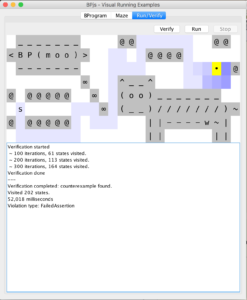The Backslash Incident
I guess it’s never a good time to find out your code has bugs. But there are exceptionally bad times to do so. A middle of a live demo is one such example. Immediately after said demo, when you’ve invited the attendees to take your code for a spin, is not too good either.
Case in point: I had the honor of presenting BPjs at a seminar at Harvard School of Engineering and Applied Sciences (SEAS). BPjs is a tool suite for running and verifying programs written in JavaScript, using the Behavioral Programming programming paradigm. In short (very very very short): It’s a paradigm that focuses on how the system should behave, rather than on how its implemented (e.g. objects, functions, or procedures). Because behavioral programs (“b-programs” for short) can be verified against a set of formal specification, BPjs allows writing verified systems in JavaScript. Which is, admittedly, weird. But in a good way.
As part of the above mentioned demo, I’ve created VisualRunningExamples, an application that allows playing with a behavioral program for a maze walker. Users can load and modify the walker’s behavioral model and formal specification, and then run or verify it, using a friendly GUI. It also serves as an example of how to build a program around a BPjs model.
One fun part of VisualRunningExample’s UI is the selection of the maze the walker would roam in. My favorite maze has a cow (created using cowsay, of course). During the presentation I let the walker walk around the cow a bit, and I thought I saw it demonstrating a bad behavior – it seemed like it was going through a wall. I’m not an expert in maze walking, but I assume maze walkers should not do that.
Immediately after the presentation, I looked into this in more depth. It seemed like the walker was moving diagonally. Which it should never do, since no part of the program requests such a move. It ostensibly went from point X to point Y:
_______
<BP(moo) > @@@@@@@@@ t
-------
\Y ^__^ @@@@@@@@
@ @@@@@ X\ (oo)_______
s (__)~~~~~~~)\/\
@ @@@@@ ||----w~|
|| ||Was this really happening? Using VisualRunningExamples, I’ve added the following b-threads, and verified the program against it. The idea behind this code is that whenever the maze walker gets into a cell, a set of b-threads that look for diagonal entries is spawned. These b-threads blow the program up if they detect a diagonal mode. Pretty neat pattern, I think (reminiscent of LSC’s symbolic charts used to forbid events):
bp.registerBThread("no-diagonal", function(){ while (true) { var crd=getCoords(bp.sync({waitFor:anyEntrance}).name); noEntryNextMove(crd.col-1, crd.row-1); noEntryNextMove(crd.col-1, crd.row+1); noEntryNextMove(crd.col+1, crd.row-1); noEntryNextMove(crd.col+1, crd.row-+1); } }); function noEntryNextMove(col, row){ bp.registerBThread("nenv(" + col + "," + row + ")", function(){ var evt = bp.sync({waitFor:anyEntrance}); var newCoords = getCoords(evt.name); bp.ASSERT( newCoords.col !== col || newCoords.row !== row, "Diagonal Movement detected"); }); } |
Verification did not find anything wrong, yet that parallel movement is happening, live, in front of my eyes. So, verification is broken too. Highly embarrassing, given that I just presented the tools at Harvard SEAS’ SPYS group. Time to do some runtime verification.
Runtime verification really boils down to adding these b-threads to the b-program (“model”), and running it. Easily done, and we know the runtime works. So, yay, next time mr. maze walker wants to do a diagonal jump, one of these b-threads will catch it red-handed. With an evil grin, I click the Run button.
Nothing. The walker does diagonal jumps like a boss. But only between points X and Y. Luckily, VisualRunningExamples’s UI is fun to play with, so I change the \ to *.
No more parallel jumps, which never really happened. Good news: BPjs’ verification works. As does its runtime.
What Went Wrong
What really happened was that when creating the source Javascript b-program, the Java layer was copying the maze into an array of strings, verbatim. This meant that \ was really an escaped space, which translates to a single space in JavaScript:
jjs$ var s = "\ " jjs$ "|" + s + "|" | | jjs$ |
The Java UI, on the other hand, displayed the backslash in the maze monitor table. In short: the JavaScript b-program saw a space there, whereas Java saw a backslash. The ostensible diagonal jumps were just the maze walker going from X to Y through an empty cell, that was marked by the Java layer as a \ cell.
Lessons Learned
- Need to be careful when constructing code from user input (OK, that’s not a very new lesson, more of a reminder really. But still).
- If you have a suspicion something is wrong in a b-program, BPjs makes it easy to verify.
- Tooling and UI that make the b-program easy to play with are very important. All in all, I went from having a suspicion to verifying the code in about an hour of casual coding on the couches at an empty student center somewhere in the Harvard campus.
- Since BPjs uses the same structures for verification and for modeling/execution (namely, b-threads written in JavaScript), it is trivial to share code between the b-program and its formal specification. That’s important, e.g., when one wants to extract data from strings.
My experience with this whole BPjs as a verification platform, is that it enables “casual verification” – it is very easy to create and run verification code, all the tools are there already, and you’re probably in the mindset as well. Compared to re-creating the system by modeling it in, say, PROMELA, it’s much more casual. Not to mention translation errors between model and actual software.
VisualRunningExamples now has a shiny new cow that does not contain any backslashes. I kept the old cow too, but it’s now called “cow (bad)”. Escaping the maze text properly is followed by issue #1.

